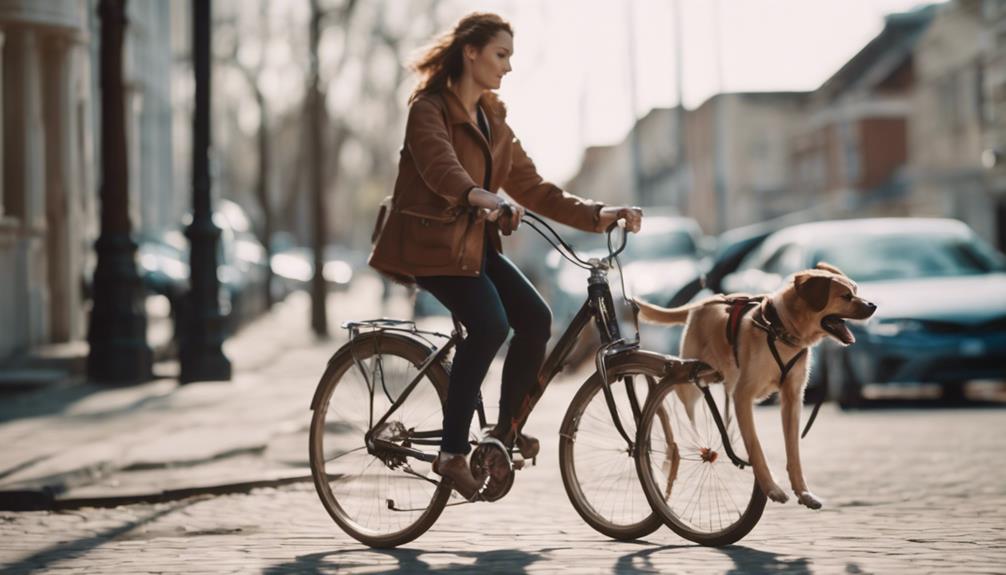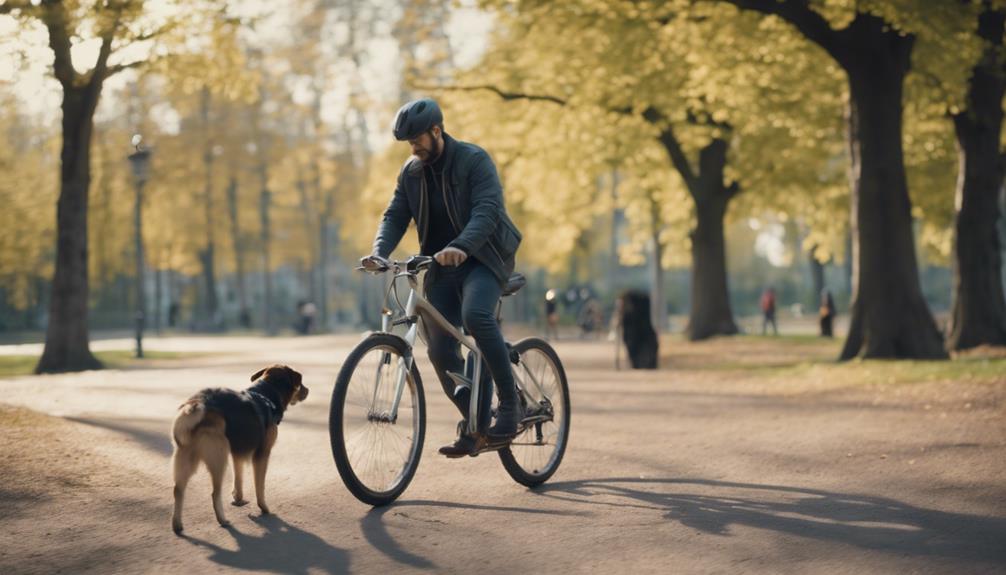As biking with dogs gains traction among outdoor enthusiasts, ensuring the safety and comfort of both canine companions and riders becomes a crucial aspect to consider.
The intersection of exercise, bonding, and recreation can be rewarding, but it also warrants careful attention to various factors.
From assessing physical capabilities to employing appropriate gear and training techniques, the path to a harmonious biking experience with your dog is multifaceted.
Understanding the nuances of this activity can lead to a fulfilling and enriching journey for you and your furry friend.
Key Takeaways
- Ensure your dog's physical capability and use specialized biking products for safety.
- Monitor for signs of exhaustion and gradually introduce biking with positive reinforcement.
- Be cautious of risks like accidents and overheating, and prioritize safety precautions.
- Consider professional guidance, recognize your dog's enjoyment, and explore alternative dog-friendly activities.
Physical Capability Assessment for Biking
Assessing your dog's physical capability for biking is crucial to ensure a safe and enjoyable biking experience for both you and your furry companion.
Before embarking on biking adventures, consider your dog's age, breed, size, and overall health. Smaller breeds or those with short legs may struggle to keep up with the pace, while larger breeds may have more stamina. Additionally, older dogs or those with joint issues may not be suitable for biking long distances.
It's essential to consult with your veterinarian to evaluate if your dog is physically fit for biking activities. By understanding your dog's physical limitations, you can tailor biking sessions to match their capabilities, promoting a positive and safe experience for both of you.
Training and Familiarization Techniques
To ensure a safe and successful biking experience with your dog, it is essential to implement effective training and familiarization techniques. Begin by teaching your dog to walk calmly beside the bike and acquaint them with its presence through positive reinforcement.
Gradually introduce short biking sessions, allowing your dog to adjust to the sounds and movements associated with riding. Practice basic commands such as 'stop' and 'go' to enhance control and communication.
Use specialized biking products like harnesses and bungee leashes for added safety. Monitor your dog's comfort level and reactions closely during training to ensure they are relaxed and receptive.
Consistent training and familiarization will help build your dog's confidence and readiness for biking adventures.
Monitoring Signs of Exhaustion
To ensure the well-being of your dog during biking sessions, it is crucial to remain vigilant for any signs of exhaustion as they adapt to this physical activity. Signs of exhaustion in dogs can include excessive panting, drooling, lagging behind, reluctance to continue, stumbling, or seeking shade.
If you notice any of these signs, it's essential to stop immediately, offer your dog water, and allow them to rest in a shaded area. Pushing a dog beyond their limits can lead to heatstroke, dehydration, muscle strain, or other serious health issues.
Monitoring your dog's behavior and physical cues throughout the ride will help you make informed decisions about when to pause, hydrate, or end the biking session.
Utilizing Specialized Biking Products
When considering biking with your dog, incorporating specialized biking products can significantly enhance safety and control during your rides. These products are designed to improve the overall biking experience for both you and your furry companion.
Here are some specialized biking products to consider:
- Dog Bike Harness: Provides a secure and comfortable attachment point for your dog.
- Bungee Leash: Helps to absorb shock and reduce sudden pulls or jerks.
- Bike Mounted Water Bottle Holder: Ensures easy access to water for both you and your dog during the ride.
These specialized products can help make your biking adventures with your dog safer and more enjoyable.
Handling Leash and Prey Drive

Considering the implications of leash handling and a dog's prey drive is crucial when biking with your canine companion. Proper leash management is essential to maintain control and prevent accidents while biking. Avoid holding the leash by hand, as this can be dangerous if your dog suddenly pulls or lunges. Opt for hands-free options like waist belts or bike attachments to ensure both hands are free for steering.
Additionally, be mindful of your dog's prey drive, which may be triggered by fast-moving objects or small animals while biking. Understanding your dog's behavior and reactions can help anticipate potential distractions and ensure a safer biking experience for both you and your furry friend.
Positive Reinforcement and Basic Commands
Implementing positive reinforcement techniques and teaching basic commands are essential aspects of preparing your dog for safe and enjoyable biking experiences. Positive reinforcement not only encourages good behavior but also strengthens the bond between you and your furry companion. Basic commands like 'sit,' 'stay,' and 'heel' are crucial for maintaining control and ensuring a smooth biking session.
To effectively train your dog for biking adventures, consider the following tips:
- Reward your dog with treats or praise for following commands.
- Practice commands in different environments to enhance your dog's responsiveness.
- Consistency is key; reinforce commands regularly to solidify your dog's understanding and obedience.
Gradual Introduction and Professional Guidance

To ensure a smooth transition into biking with your dog, a gradual introduction coupled with professional guidance can significantly enhance the overall experience for both you and your canine companion.
Start by acclimating your dog to the bike and biking environment slowly. Allow them to sniff around, get comfortable with the bike, and associate it with positive experiences. Begin with short walks alongside the bike before progressing to actual rides. Monitoring your dog's behavior and comfort level throughout this process is crucial.
If you encounter challenges or feel unsure about how to proceed, seeking advice from a professional dog trainer or veterinarian specializing in canine sports can offer valuable insights and support. Their expertise can help tailor the biking experience to suit your dog's individual needs and ensure a safe and enjoyable journey together.
Conclusion
In conclusion, biking with your dog can be a safe and enjoyable activity with proper preparation, training, and equipment. By assessing your dog's physical capability, utilizing specialized biking products, and implementing training techniques, you can ensure a positive experience for both you and your furry companion.
Monitoring signs of exhaustion, handling leash and prey drive appropriately, and gradually introducing your dog to biking are essential considerations for a successful outing. Remember to prioritize safety and enjoy your time biking with your dog.




